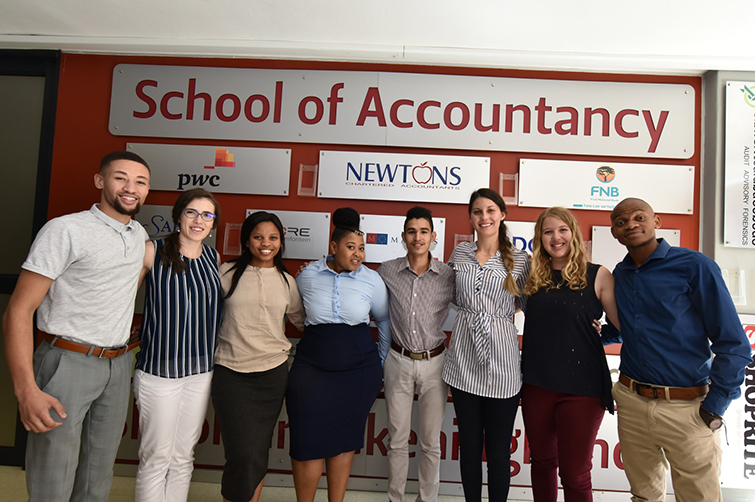Latest News Archive
Please select Category, Year, and then Month to display items
02 April 2019
|
Story Valentino Ndaba
|
Photo Charl Devenish
 Pictured are 8 of the 64 UFS School of Accountancy students who form part of the 84.2% pass rate achievers.
Pictured are 8 of the 64 UFS School of Accountancy students who form part of the 84.2% pass rate achievers.
Students from the University of the Free State (UFS) School of Accountancy achieved a 84.2% pass rate compared to the national average of 76.2% during the Initial Test of Competence (ITC) examination facilitated by the South African Institute of Chartered Accountants (SAICA).
A total of 64 out of 76 UFS students who attempted the ITC for the first time were successful in the examination. The ITC is known for its challenging nature. Demographically, our African black students outperformed the 62.1% national pass rate by attaining an impressive 80.6%.
Collective congratulations
Prof Hentie van Wyk, Programme Director at the school, attributed diligence for the high pass rate. “This is due to our student-centred teaching module that was introduced four years ago and committed academic staff of the School of Accountancy from the first to the fourth year.”
Further future surge expected
“With the coming June 2019 ITC sitting, our pass rate for 2019 will most probably be more than 90%. Our three-year rolling average for 2015-2017, 2016-2018 and 2017-2019 were 83%, 86% and 90% respectively. Hopefully we can maintain the upward curve,” said Prof Van Wyk.
Inaugural lecture: World on verge of agricultural revolution
2008-05-19
|
 A changing economic climate and new technology will see to a number of interesting changes in the livestock industry in the next few years. This is according to Prof. Frikkie Neser of the Department of Animal and Wildlife and Grassland Sciences, who delivered his inaugural lecture at the UFS on the subject: “The quest for a superior animal”. A changing economic climate and new technology will see to a number of interesting changes in the livestock industry in the next few years. This is according to Prof. Frikkie Neser of the Department of Animal and Wildlife and Grassland Sciences, who delivered his inaugural lecture at the UFS on the subject: “The quest for a superior animal”.
Prof. Neser focused on the future of animal breeding in the next few decades.
He said the world, but especially South Africa, stand on the verge of a revolution in the agriculture sector. The whole production scenario will probably change. The high fuel and food prices are the two biggest factors that will play a role.
“Increasing fuel prices opened the door for the production of bio-fuel. The fuel industry is in direct competition with humans and the livestock industry for the same resource that result in unbelievable high prices for maize, sunflower and soya. These prices can further increase with the worldwide shortage of food,” he said.
More profitable breeds could take the place of existing breeds because of the big increase in input costs, he said. “Selection for more effective, and not maximum production, will became more important.
“There are also indications of pressure on feed lots. If this industry downsizes, it could lead to a total turnaround in the beef industry. The feed lots prefer a later maturing animal that can put on a lot of weight before fat is laid down. If this industry declines, early maturing breeds and some of the synthetic breeds, as well as crossbreeding with early maturing breeds, will play a more prominent role in the meat industry.
“This will also lead to a decline in the total number of animals in order to prevent overgrazing. This can result in an increase in imports from neighbouring countries and especially Brazil, where production costs are much lower.
“One way to increase the profitability of meat production is to utilise niche markets. There is world-wide a shift to more natural products. The demand for grass-fed beef drastically increased. According to research it is healthier than meat from feed lots and usually free of hormones and antibiotics. If factors such as traceability are put in place, this could be a very profitable niche mark for the South African meat industry,” he said.
Prof. Neser also said: “In order for breeding societies to survive they need to increase the number of members and the animals that are being registered. This they do by replacing the word stud with recorded animals. Hereby they open the door for excellent commercial animals to become part of the seed-stock industry. Another benefit is that especially in the smaller breeds more information becomes available, resulting in more accurate breeding values.”
Prof. Frikkie Neser.
|